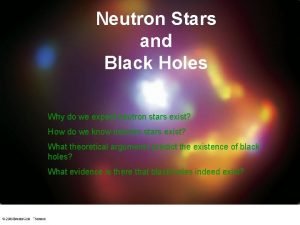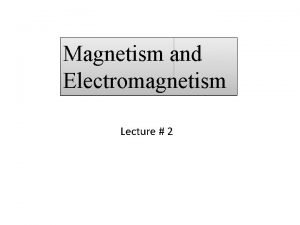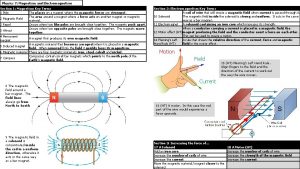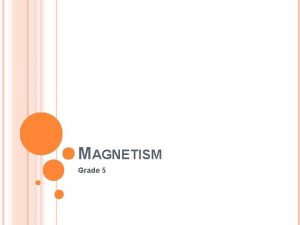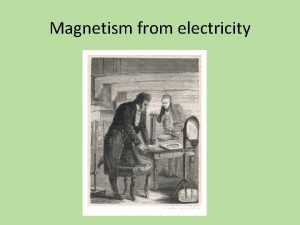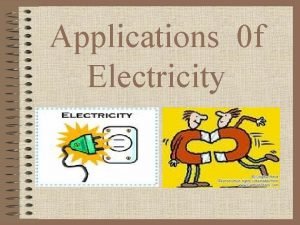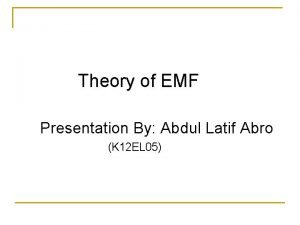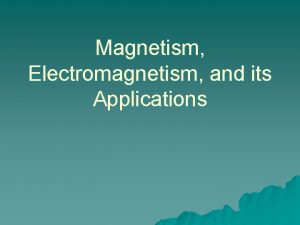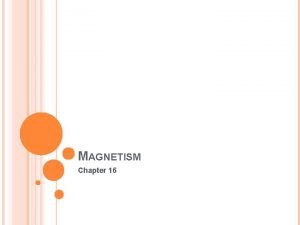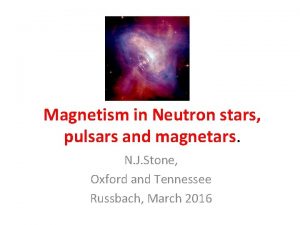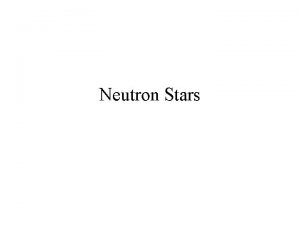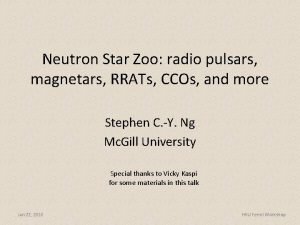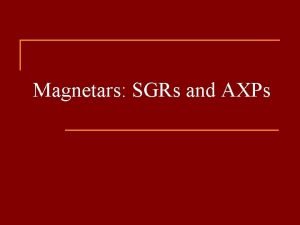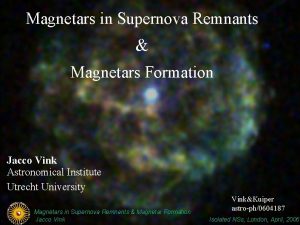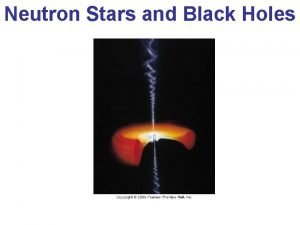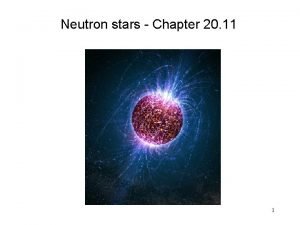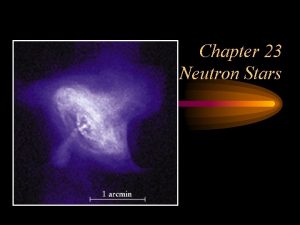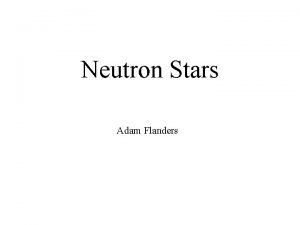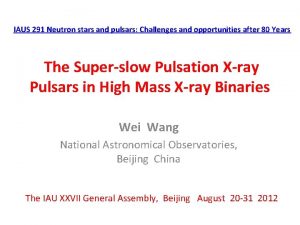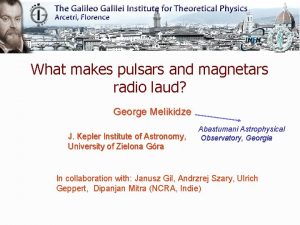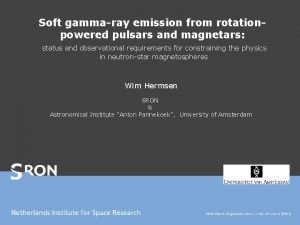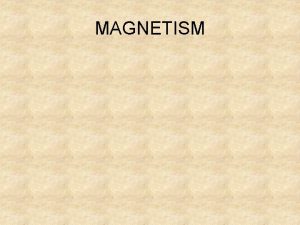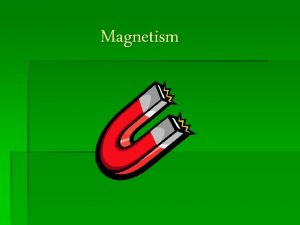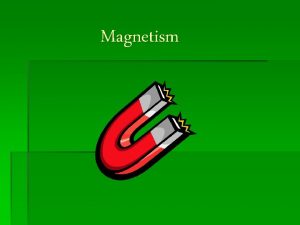Magnetism in Neutron stars pulsars and magnetars N



















- Slides: 19

Magnetism in Neutron stars, pulsars and magnetars. N. J. Stone, Oxford and Tennessee Russbach, March 2015

Outline – very general survey talk at an introductory level to take any topic further consult references and move on from there. What is a neutron star (NS)? Internal and external structure How large are NS magnetic fields? Field configurations in rotating, conductive bodies Possible mechanisms for generation of sufficient fields Conclusion

Is stellar magnetism significant? strong; coulomb: gravity … ? Start with the earth Surface field weak non-axial wandering axis with infrequent reversals understood(? ) Environmental field: magnetosphere ionosphere rotating charges deflection of solar wind inportance

How different are neutron stars? Compared to earth Earth Neutron star Mass 6 x 10^24 Kg ~ 1. 5 x solar … 3 x 10^30 Kg Radius 6400 km 10 km Surface gravity g ~ 10 m/s^2 1. 6 x 10^11 m/s^2 Volume 1. 1 x 10^21 m^3 4. 2 x 10^12 m^3 Mean density 5. 5 x 10^3 Kg/m^3 7. 1 x 10^17 Kg/m^3 Expect application of the laws of physics in a very different regime No practical possibility of terrestrial experimantation Dependent upon and observation (all aspects: spectrum. timing, deduced location …. ) theory, pushed to extreme limits

The Challenge: magnetism in neutron stars Neutron stars Products of cataclysmic explosions of stars at the end of their burning cycle when gravity causes collapse and disruption with loss of > 70% of material Properties: Position Motion Pulsars Mass ~ 1. 5 M(s), Radius ~ 10 km, Energy ~ 10^51 erg Temp initially ~ 10^10, cooling to ~ 10^8 K In the vicinity of supernova remnants Can be travelling at > 10, 000 km/s wrt surroundings Subgroup (~10%) of neutron stars which exhibit ‘lighthouse’ like emission of EM radiation over a wide wavelength range. Directed emission thought to be result of magnetic dipole field rotating at an angle to the axis of rotation of the star. Fields in the region of 10^11 – 10^12 G [10^7 – 10^8 T]. Properties: Slow down of period. Glitches (abrupt small changes) Magnetars Further subgroup (~3%) with even higher fields ~ 10^14 - 10^16 G

Neutron star structure Atmosphere - thin Outer crust Inner crust Core beta equilibrium requires presence of protons, electrons and (great majority) neutrons. Inner core Likely to contain hyperons and heavier mesons Conductivity By highly relativistic electrons in all regions until mesons appear.

Beyond the stellar surface. Magnetosphere standard model considers this divided into regions of open and closed field lines. Magnetosphere rotates with the NS out to where this would imply velocities > vel. of light. . Closed field region filled by charged particles such that their electric field, in the rotating reference frame, cancels that from rotation of the star. Open field region has strong electric field which accelerates charged particles to close to speed of light. Particle motion in magnetic field causes emission of cyclotron radiation. Pulsars also emit gamma, x-ray and thermal radiation. Role of magnetosphere in radiation propagation: detailed analysis of radiative propagation in plasma is complex (Potehkin 2014). Observable radiation varies with B field and temperature, which are not uniform across the star surface. Composition of thin atmosphere ions (H, He) affects spectrum. Such questions of great importance in attempts to extract neutron star radii.

Evidence for magnitude of magnetic field in pulsars Some spectra (in pulsars accreting material from a binary partner) show lines which have been associated with electron cyclotron resonance involving radiation from electrons orbiting the field lines. Frequencies correspond to fields of up to ~ 1. 4 x 10^12 G. For isolated pulsars use is made of the relation between the period of rotation and its slowing, assuming magnetic dipole radiation and certain star parameters (R, I, alpha). d. W/dt = - 2 R 6 B 2 W 3 sin 2 a/3 I The results again show B ~ 10^12 G.

Magnetic fields beyond and within the star. General remarks. Simple dipolar magnetic fields are unstable in systems which can support currents such as NS interiors. In these there is a more stable configuration involving a dipolar component ( a poloidal field) and a toroidal field. The latter may not be ‘visible’ at the star surface. Conduction is by highly relativistic electrons (and superconductive protons). Superconductive currents are considered to flow at the core – inner crust interface Fujisawa and Kisaka MNRAS 445 2777 (2014)

More elaborate field profiles combining poloidal and toroidal fields Fujisawa and Kisaka MNRAS 445 2777 (2014)

Origin of magnetic fields: circulating currents or intrinsic magnetisation of constituents of matter Suggested origin of NS fields Langer (2013), Spruit (2008) 1. Fossil fields Inherited from precursor star by flux conservation through reduced surface area. How is problematic. 2. Dynamo processes circulating currents (see references to a-W dynamo) Rossby Number: Ratio of inertial to convective forces. Governs Coriolis as opposed to convective contribution to dynamo magnetic field amplification in stars. Reynolds Number: ratio of inertial to viscous forces. Low value – streamline flow: High value – turbulent flow with eddies. Dynamo action requires R above a specified value to be sustained. In neutron star matter R >> 1 (Thompson and Duncan 1993) 3. Constituent magnetisation Polarisation of electrons, protons, neutrons ? ? ? All have intrinsic magnetic moments

Fossil fields For the first years after the discovery of pulsars the thinking was that these remnants of precursor main sequence stars could ‘inherit’ their huge magnetic fields, either direct from the progenitor or even from the primordial pre-stellar medium. Some stars have fields in the 10^4 G range and radii of (few x 10^6) km. If magnetic structure were somehow maintained during the supernova process then, with radius reduced to ~ 10 km, fields (flux/ area) could reach 10^4 x [(4 10^6/10)]^2 ~ 10^15 G. Later thinking realised that such flux conservation is unlikely (Spruit ). Mass loss during the explosion and the smaller initial area of the remnant as part of the precursor core brings the maximum below that observed in magnetars, even for an initial 10^4 G precursor. Furthermore only very few precursors have fields ~ 10^4 G. These and other technical arguments have led to the dropping of this idea as the source of neutron star fields.

Dynamo effect and field amplification (no detail - ref NOVA What drives the earth’s Magnetic Field ? ) When a conducting medium moves through a magnetic field it constitutes a current, which, in turn, produces a second field. This field adds to the first and hence produces a field which is larger. This ‘amplification’ requires energy input to sustain the fields and currents, and there are losses through viscous and other resistive forces. In the earth, energy is derived from slow ‘freezing’ of the inner surface of the liquid outer core onto the inner solid core, the heat so generated driving convective action which keeps the liquid outer core moving through the field. Coriolis effects also contribute by imparting a spiraling motion to the moving liquid (just as in the bath or so they say!) and such spirals generate additional magnetic field sources, which are roughly aligned and add to the total field. This may contribute to the SN explosion (Obergaulinger, Janka, Aloy MNRAS 445 3169 (2014) Convective motion of a conducting medium is a typical feature of many types of star structure: seen as the principal means of generation of magnetic fields. The convection may be driven by any type of entropy gradient: T …. . Composition, ….

Collective magnetism in (neutron) stars History: Brownell and Callaway 1969, Rice (1969) Silverstein (1969) see Heansel and Bonazzola (Astron Astro 314 1017 (1996)) First ideas : Neutron pair interaction favours triplet state (S = 1) at high density which avoids short range strongly repulsive n-n interaction in singlet (S = 0) state by Pauli Princ. This would lead to ‘ferromagnetic’ (F) transition above some critical density and below a critical temperature T(c). Later: Detailed calculations showed dense pure n matter would not undergo F transition. However the addition of a small proton density was shown to predict a stable polarised system (Kutschera and Wojcik P Lett B 223 11 (1989). Full polarisation produces far too HIGH a magnetisation density (10^16 G) for the observed normal pulsar fields, but high enough to produce magnetars (~ 10^15 G). Details existence of Domains as in F materials reduce effective magnetisation Screening of core field by inner crust proton superconductivity (Type I would give total screening, Type II partial screening) Non-coaxiality: result of complex domain structure? Magnetisation in NS produced during initial cooling phase since ordering temp ~ 10^10 K. thereafter frozen in but domain structure could modify as temp falls and neutron superfluidity temperature passed.

Coexistence of dynamo and collective magnetism Possible evidence General: Wide range of observed magnetisations in N stars and white dwarfs Specific: Angle a between resultant magnetic dipole field and rotation axis is slowly changing. (Lyne et al. , Science 342 598 (2013) Crab pulsar pulse analysis) Data: Pulsar pulses have structure. Separation in time of different components is found to change over the 22 years of observation of this pulsar in a way consistent with change in angle a at rate of 0. 62 degree per century towards orthogonality of the two axes. Mechanism for a change. Two non-coaxial dipoles exert couple tending either to perpendicular or parallel configuration dependent upon initial configuration.

Conclusions Two mechanisms proposed for origin of stellar magnetism, Both claim to produce fields as observed in both regular pulsars and in magnetars. There seems no clear reason why they cannot co-exist. Both are consistent/compatible with other aspects of NS structure including Superconductivity Superfluidity. Pulsar Glitches: rapid small step changes in period. Origin not fully determined. Possibly related to adjustment as superfluid component shares angular momentum with the normal component after this has lost energy and slowed.

A wonderfully open field for new ideas which demand new observations and sophisticated analysis. Source: presentation by C. Auer ‘ABC of Magnetars’ 2008 Thank you


 Neutron star
Neutron star There are millions of stars in the space
There are millions of stars in the space Isis neutron and muon source
Isis neutron and muon source Physics 102
Physics 102 Ib physics topic 5 questions and answers
Ib physics topic 5 questions and answers Electricity and magnetism lecture notes
Electricity and magnetism lecture notes Artificial magnet example
Artificial magnet example Electricity and magnetism jeopardy
Electricity and magnetism jeopardy Sph3u electricity and magnetism
Sph3u electricity and magnetism Magnetism and electromagnetism
Magnetism and electromagnetism Electromagnet experiment hypothesis
Electromagnet experiment hypothesis Magnetism and electricity
Magnetism and electricity Grade 5 electricity and magnetism
Grade 5 electricity and magnetism Electricity and magnetism
Electricity and magnetism Solenoid bbc bitesize
Solenoid bbc bitesize Electric fuse and circuit breaker graphic organizer
Electric fuse and circuit breaker graphic organizer Ampere
Ampere Para and ferro magnetism
Para and ferro magnetism Electromagnetism vs magnetism
Electromagnetism vs magnetism How does a compass work
How does a compass work
